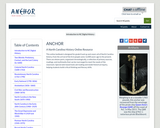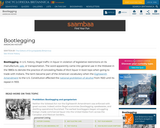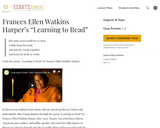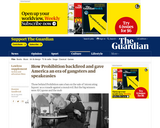
This parent guide supports parents in helping their child at home with the 8th grade Social Studies content.
- Subject:
- Social Studies
- Material Type:
- Reference Material
- Vocabulary
- Author:
- Kelly Rawlston
- Letoria Lewis
- Date Added:
- 10/12/2022

This parent guide supports parents in helping their child at home with the 8th grade Social Studies content.

This resource accompanies our Rethink 8th Grade Social Studies course. It includes ideas for use, ways to support exceptional children, ways to extend learning, digital resources and tools, tips for supporting English Language Learners and students with visual and hearing impairments. There are also ideas for offline learning.

This online textbook is designed for grade 8 and up and covers all of North Carolina history, from the arrival of the first people some 12,000 years ago to the present. There are eleven parts, organized chronologically, a collection of primary sources, readings, and multimedia that can be rearranged to meet the needs of the classroom. Special web-based tools aid reading and model historical inquiry, helping students build critical thinking and literacy skills.

Containing more than 50 articles from the award-winning Tar Heel Junior Historian magazine and over 40 lesson plans, this multidisciplinary Educator Notebook will enrich your exploration of North Carolina and American history with diverse perspectives. This resource's link takes you to a very short form that gives you free downloadable access to the complete PDF book.

Students will learn about Princeville, NC, the oldest town in the United States incorporated entirely by African Americans. Students will learn about the challenges that faced newly freed slaves.

This resource explains how bootlegging came about as a result of the Prohibition Amendment.

This collection of primary resources and corresponding activities sheds light on the endurance of peaceful protesters in Montgomery, Ala., who overturned an unjust law.

In this lesson, students will review and summarize questions about the struggle for equality and apply them to other civil rights struggles. Students will also devise a timeline regarding other civil rights struggles.

In this activity, students examine an artifact and answer a series of questions. The questions are designed to guide students into a deeper analysis of the source and sharpen associated cognitive skills.

Students will see and read about the differences in food manufacturing practices before and after the new food laws passed in 1906: the Pure Food and Drug Act and the Meat Inspection Act.

In this lesson, students will explore the contributions African Americans have made to North Carolina by examining the “SERVICE” mural commissioned by the School of Government at UNC-Chapel Hill. The mural, which depicts key African-American leaders in North Carolina, is a stunning visual for teaching students about our state’s history. After examining and interpreting the mural in small groups and through class discussion, students will choose and research one of the figures pictured in the mural. Students will then apply what they have learned by writing a monologue in which this figure speaks about his/her life in first person. The project will culminate with students dressing as their chosen figure and “bringing the mural to life” by presenting a 3-4 minute monologue in the character of their historical figure.

This presentation is intended for use with the lesson "Exploring African American Leadership and Service in North Carolina." In this lesson, students will explore the contributions African Americans have made to North Carolina by examining the "SERVICE" mural commissioned by the School of Government at UNC-Chapel Hill. The mural, which depicts key African-American leaders in North Carolina, is a stunning visual for teaching students about our state's history. After examining and interpreting the mural in small groups and through class discussion, students will choose and research one of the figures pictured in the mural. Students will then apply what they have learned by writing a monologue in which this figure speaks about his/her life in first person. The project will culminate with students dressing as their chosen figure and bringing the mural to life by presenting a 3-4 minute monologue in the character of their historical figure.

In this lesson, students will examine the impact of North Carolina's economic and technological advances on the environment, as well as North Carolina organizations and laws created to address such impact, by connecting these issues to those posed in Dr. Seuss's The Lorax. Though classified as a children's book, The Lorax contains mature themes regarding the increasing negative effects human action and irresponsibility is having on the environment. In this lesson students will read the story or watch the movie and hold a mock hearing of the North Carolina Environmental Management Commission about the damage the Onceâ€ler has done to the environment.

In this lesson students do a close reading of “Learning to Read,” a poem by Francis Watkins Harper about an elderly former slave which conveys the value of literacy to blacks during and after slavery. The activities also prompt students to examine the nature of literacy in the 21st century and the value they put upon it.

This interactive site provides primary resources and curator interviews designed to focus on the lunch counter as an object in historical context. Also provided are a lesson plan and annotated links to other online resources to expand student understanding of the topic.

This resource explains how Prohibition backfired and gave America an era of gangsters and speakeasies.

In this activity, students will watch and discuss a 22-minute video of a theater presentation created by the Smithsonian’s National Museum of American History. The activity could also include an in-classroom simulation, extension activities, and a sing- along performance of a freedom song.

In this lesson, students will discuss the concept of democracy and through this lens, analyze the unjust Jim Crow laws that dominated the South. Through discussion, readings and the examination of primary sources, students will gain an understanding of how the period immediately following World War II set the stage for numerous challenges to Jim Crow, one of which was the 1947 Journey of Reconciliation. Students will culminate this lesson by creating a historical marker that honors the Journey of Reconciliation’s riders and educates the public about this important period of history.

In this 2-part lesson, students identify diaster-related activities in which the benefits of government action outweigh the costs and use economic analysis to explain the obstacles to success in the diaster-relief activities where government frequently falters.

In this lesson, students will explore what it means to be an active, engaged citizen by sharing moments from their own lives. Students will then explore a tumultuous period of southern history, the Jim Crow Era, when it took numerous active, engaged citizens and community members to fight against the inequality and injustice of southern laws. This lesson will culminate with students teaching classmates about an historical figure representative of an active, engaged citizen by creating a “living†museum exhibit. (Teacher Note: The “living†museum activity can be used with any historical time period or theme throughout your curriculum.)